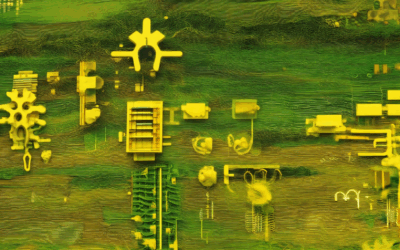In an era marked by unprecedented technological advancements, the intersection of creativity and innovation has never been more dynamic. The creative industries, long driven by human ingenuity, are now witnessing a transformative shift as new technologies emerge to redefine the boundaries of artistic expression, production, and consumption. From artificial intelligence to virtual reality, these tools are not just revolutionizing how we create but also reshaping the very essence of creativity itself. As we delve into 2023, one thing becomes clear: technology is becoming an indispensable ally in the pursuit of creativity, offering both unprecedented possibilities and fresh challenges. This article explores how these technologies are shaping the creative landscape, examining their role in enhancing creativity, providing real-world examples, and considering the future trajectory of AI in creative industries. We’ll also examine the diverse creative industries thriving today, the most profitable among them, and the various models that define this evolving sector. Join us as we uncover the fascinating interplay between creativity and technology in an increasingly connected world.

Technologies in the Creative Industries
The creative industries are rapidly evolving with the integration of advanced technologies, enabling new forms of creativity, collaboration, and audience engagement. Here are some key technologies shaping this transformative landscape:
1. Immersive Technologies
- Virtual Reality (VR) : Creates fully enclosed environments where users can interact with digital content, revolutionizing fields like gaming, education, and entertainment.
- Augmented Reality (AR) : Enhances real-world environments with digital overlays, widely used in advertising, architecture, and manufacturing.
- Mixed Reality (MR) : Combines VR and AR, offering hybrid experiences for applications in healthcare, gaming, and industrial design.
2. Artificial Intelligence (AI)
- AI powers tools like Iterati ‘s platform, enabling generative art, personalized content, and automated creative workflows.
- AI-driven tools assist in tasks such as video editing, music composition, and 3D modeling, significantly accelerating creative processes.
3. Cloud Technology
- Cloud-based platforms facilitate remote collaboration and storage, allowing artists and teams to work globally on projects like film, animation, and game development.
- Tools like Adobe Cloud and Microsoft 365 are integral to modern creative workflows.
4. 5G Technology
- High-speed 5G networks enable real-time streaming, virtual production, and instant access to large datasets, crucial for live events, broadcasting, and interactive media.
5. Blockchain and Distributed Ledger Technology
- Blockchain is used for secure digital asset management, intellectual property protection, and decentralized collaborations, particularly in the music and entertainment industries.
6. Machine Learning and Deep Learning
- Machine learning algorithms analyze vast datasets to predict trends, recommend content, and enhance creative outputs, as demonstrated by platforms like DeepMind .
7. Interactive Content Creation
- Tools like Unity and Unreal Engine allow creators to develop immersive experiences across various industries.
8. Collaboration and Project Management Tools
- Platforms like Slack and Asana streamline teamwork, enabling efficient coordination among global creative teams.
By leveraging these technologies, the creative industries continue to push boundaries, fostering innovation and delivering unparalleled experiences to audiences worldwide.
Examples of Creative Technology
Creative technology encompasses a wide range of innovations that integrate technological advancements with artistic expression, design, and innovation. Below are some notable examples:
- Multi-Sensory Experiences: Technologies like computer graphics and virtual reality (VR) create immersive environments that engage multiple senses. Examples include VR arcades, interactive art installations, and 360-degree films.
- Digital Music and Audio Production: Tools like Ableton Live, Logic Pro X, and synthesizers allow artists to create and manipulate sound digitally. This has led to genres like electronic music and lo-fi beats gaining global popularity.
- Virtual and Augmented Reality (VR/AR): Technologies like Oculus Rift and Microsoft HoloLens enable users to interact with digital worlds. Applications range from gaming and education to industrial training and architectural visualization.
- Video Editing and Visual Effects: Software like Adobe Premiere Pro and Autodesk Maya are used to create high-quality videos and visual effects. This has been instrumental in the creation of movies, commercials, and online content.
- Software Engineering and App Development: Creating apps that solve problems creatively, such as productivity tools or fitness trackers, demonstrates the intersection of technology and creativity.
- 3D Printing and Additive Manufacturing: This technology allows for the creation of complex shapes and prototypes, enabling innovation in industries like healthcare, aerospace, and architecture.
- The Internet of Things (IoT): Integrating devices into everyday objects creates smart environments. Examples include smart home systems, wearables, and connected vehicles.
- CAD/CAM and Digital Design: Computer-Aided Design and Computer-Aided Manufacturing tools enable precise creation of digital models, used across industries like automotive, aerospace, and fashion.
- Wearable Technology: Devices like smartwatches, fitness trackers, and augmented reality glasses combine functionality with creative design, enhancing user experiences in health and productivity.
These technologies not only push boundaries in their respective fields but also drive innovation across industries, demonstrating the limitless potential of creative technology.

The Future of AI in Creative Industries
AI is revolutionizing the creative landscape, offering unprecedented opportunities across various sectors. While it enhances creativity rather than replacing human ingenuity, its impact is profound and multifaceted.
Content Creation and Storytelling
AI tools are democratizing content creation, enabling faster and more efficient storytelling. Machine learning algorithms can analyze vast datasets to generate nuanced narratives, tailor content to specific audiences, and optimize engagement. For instance, AI-driven video editing software can seamlessly stitch together clips, while generative design tools can autonomously create visual assets.
Design and Visualization
In the realm of design, AI is becoming a powerful collaborator. Designers use AI to automate repetitive tasks, such as logo design or UI prototyping, allowing them to focus on innovative concepts. AI-powered platforms like Adobe Firefly can even analyze images and suggest design enhancements, significantly accelerating the creative process.
Marketing and Advertising
AI is reshaping marketing through dynamic content generation and personalized campaigns. AI algorithms can analyze consumer behavior to craft hyper-targeted ads, optimizing both delivery and effectiveness. Tools like HubSpot’s AI-driven marketing automation ensure campaigns adapt in real-time to audience interactions, driving better ROI.
Entertainment and Gaming
AI is transforming entertainment by enhancing production quality and personalization. Virtual production techniques powered by AI enable filmmakers to create immersive experiences, while AI-generated music and sound effects are becoming standard in media production. In gaming, AI-driven NPC behaviors and procedural generation techniques are redefining story arcs and gameplay.
Challenges and Considerations
While AI presents immense opportunities, challenges remain. Issues like copyright infringement, bias in AI-generated content, and the ethical implications of AI decision-making require careful navigation. Creators must balance efficiency gains with the preservation of human creativity and artistic integrity.
A Roadmap for the Future
Looking ahead, AI will likely play a pivotal role in every stage of the creative process. From ideation to execution, AI tools will continue to augment human capabilities, fostering collaboration and innovation. As the technology evolves, creative professionals will need to adapt, embracing AI as a partner rather than a competitor.
Iterati.org explores these innovations in-depth, offering insights into how businesses can leverage AI to drive growth and innovation. Explore our resources to discover how AI is shaping the future of creativity.

What Are the 13 Creative Industries?
The creative industries encompass a diverse array of sectors that drive innovation, cultural expression, and economic growth. These industries play a crucial role in shaping our modern society, from entertainment to technology. Below is a comprehensive list of the 13 major creative industries:
- Advertising : This industry focuses on creating persuasive messages and marketing campaigns to promote products and services.
- Architecture : Involves the design of buildings, urban planning, and spatial design to create functional and aesthetically pleasing environments.
- Art : Encompasses visual arts, fine arts, and artistic expression across various mediums like painting, sculpture, and photography.
- Crafts : Includes traditional and contemporary craftsmanship, such as pottery, textiles, and jewelry-making.
- Design : Covers industrial design, graphic design, interior design, and fashion design, focusing on creating visually appealing and functional designs.
- Fashion : Involves the creation of clothing, accessories, and footwear, driven by trends and individual style.
- Film and Television : Includes the production of movies, television shows, and other visual media, involving storytelling, cinematography, and editing.
- Music : Comprises composition, performance, and production of musical works across various genres.
- Performing Arts : Encompasses live performances in theater, dance, circus arts, and other stage-based disciplines.
- Publishing : Involves the creation, editing, and distribution of written content, including books, magazines, and digital media.
- R&D (Research and Development) : Focuses on innovative thinking and experimentation to develop new technologies and creative tools.
- Software : Involves programming and development of computer software, including applications, games, and operating systems.
- Toys and Games : Creates products designed for children’s entertainment and learning, ranging from board games to interactive toys.
- TV and Radio : Includes the production and broadcasting of radio programs and television content for mass audiences.
- Video Games : Involves the creation of interactive digital games for entertainment and recreational purposes.
These industries not only contribute to cultural enrichment but also drive significant economic activity. Companies like Apple , Adobe , and Netflix are prominent players in several of these sectors, showcasing their impact on the global market. By supporting these industries, we invest in innovation, creativity, and the continued evolution of our world.
The Most Profitable Creative Industries
The creative industries encompass a wide range of sectors, each contributing significantly to global revenue. According to the House of Lords Library report “Creative Industries: Growth, Jobs and Productivity,” the film and television industry stands out as one of the most profitable segments due to its high gross value added (GVA) and global demand for entertainment content.
1. Film and Television
- The film industry alone generated over $40 billion globally in 2023, driven by box office revenues, streaming services, and production investments.
- Major players include Hollywood studios like Disney, Netflix, and Warner Bros., which dominate the market with their extensive catalogs and exclusive content distribution.
2. Advertising
- Advertising is another highly profitable segment, with global spending exceeding $500 billion annually.
- Companies like Google Ads, JWT, and Omnicom Media Group thrive in this space by leveraging data analytics and targeted marketing strategies.
3. Music
- The music industry continues to evolve with the rise of streaming platforms like Spotify and Apple Music.
- Revenue streams include record labels, live performances, and licensing deals, with artists like Taylor Swift and Drake generating substantial income through partnerships and tours.
4. Fashion
- The fashion industry is valued at over $450 billion annually, driven by luxury brands like Gucci, Nike, and H&M.
- Designers, brands, and retailers benefit from high-margin product lines, exclusive collaborations, and global retail networks.
5. Video Games
- The video game industry has grown exponentially, with revenues surpassing $150 billion in recent years.
- Platforms like Twitch, Fortnite, and Minecraft dominate the market, attracting millions of viewers and players worldwide.
6. Publishing
- The publishing industry, including books, magazines, and digital content, contributes significantly to revenue through sales and subscriptions.
- Companies like Amazon Kindle and Condé Nast capitalize on diverse audiences and niche markets to maximize profitability.
7. Digital Media and Marketing
- Digital media platforms like YouTube, Instagram, and TikTok have become powerful tools for brands and creators.
- Marketers invest heavily in social media campaigns, influencer partnerships, and content creation to reach target audiences effectively.
These industries demonstrate the vast potential of creative endeavors to generate substantial profits, driven by innovation, audience engagement, and strategic business models.

What are the four models of creative industries?
The creative industries operate under distinct models that shape their dynamics and contributions to society. These models provide frameworks for understanding how creative businesses function and interact with their environments.
- Welfare Model: This model emphasizes the role of creative industries in supporting societal well-being. It often involves public funding and policies aimed at fostering cultural development and artistic expression. Governments and institutions play a significant role in promoting this model through grants, subsidies, and educational programs.
- Competition Model: In this framework, the focus is on the competitive nature of creative industries. Businesses and creators strive to innovate, differentiate themselves, and capture market share. This model drives advancements in technology, design, and storytelling as participants seek to outperform rivals.
- Growth Model: This model highlights the expansion and evolution of creative industries. It focuses on factors like technological progress, market expansion, and investment in research and development. Examples include the growth of the film industry with advancements in special effects and streaming platforms.
- Innovation Model: Here, the emphasis is on the creation of new ideas, products, and services. Creative industries thrive on innovation, whether through groundbreaking music compositions, revolutionary designs, or pioneering technologies that transform industries.
These models collectively define the landscape of creative industries, showcasing their adaptability and impact on various aspects of society.




0 Comments